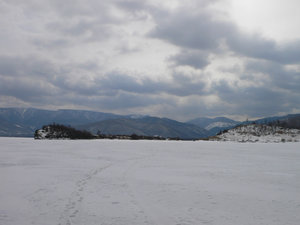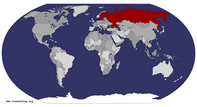Advertisement
Published: June 13th 2013

 P1010765
P1010765
Lake BaikalMy next stop in Siberia was the one I was looking forward to most. Irkutsk is a pleasant enough city, but it's real appeal is its proximity to Lake Baikal. Baikal is the world's largest, deepest and oldest lake. Also called 'The Pearl of Siberia,' at its longest is 636 km long, its greatest width is 79 km and its greatest depth is an incredible 1642 meters. It holds 23,615.39 km
3of water, or 20%!o(MISSING)f the world's fresh water; the water is also drinkably pure, and is so clear that you can see up to 100 meters down into it. It's formed by a tectonic rift and is getting bigger every year; in a few million years it's expected to become the world's fifth ocean, dividing the Eurasian continent. It's UNESCO world heritage site, and is home thousands of species of plants and animals, most of which are not found anywhere else on earth. In short it's an essential stopping point in Russia, and I gave myself a few days to explore it.
I arrived at Irkutsk station, and had the usual faff finding a hostel. The place I'd booked turned out to be a home-stay with a lovely and

 P1010766
P1010766
Ulan-Ude train stationhelpful Russian lady, conveniently situated in the center of town. No sign to indicate her flat was also the 'Baikal Explorer Hostel' but fortunately I caught her on her way back from shopping. I dumped my bags and made a few plans for the next few days around the lake, and then decided to go out for a run. I ran along the riverside, and was just thinking of turning back, when I saw the riverside road continuing on a little further under a bridge, now unlit and running past a few chained gates. As I went under the bridge, three stray dogs appeared, a common sight in Russia. The dogs barked warningly at me. 'I'm not afraid of dogs, I know how to deal with them' I thought, 'I'll just keep to the other side of the road and they'll ignore me.' Idiot. As I approached they suddenly rushed up, and one of them bit my leg. Not a bad bite, but it broke the skin, and Russia is not free of rabies, and these were stray dogs. Rabies is 100% fatal if not treated. Oh shit.
I'd already had the Rabies vaccine back-home, but if you're exposed

 P1010777
P1010777
Giant Lenin Headto rabies, even if you are already vaccinated you still need to have two further jabs of the vaccine (one immediately afterwards, one 2 days afterwards). If you haven't had the vaccine, you need to have 5 jabs, plus something called human immunoglobulin, which is very expensive and hard to come by. So, on my first night in the home-stay I had to ask the kindly lady to take me to the public hospital up the road and help me get the post-exposure jab. The hospital was not a pleasant or high budget place, with peeling paint, cracked walls, exposed electrical wires and overflowing bins. I also had to go again two days later, this time in the daytime when the hospital was a chaotic scrum of disfigured and ill people waiting to be seen, and the poor over-stretched doctors clearly did not want to be dealing with idiot foreigners who didn't speak a word of Russian.
So, all in all, this ruined my chances of spending extended time by the lake. I did manage to make one day trip there however. Irkutsk is actually 70 km from the lake, with the lakeside village of Listvyanka being the most

 P1010782
P1010782
Frozen river, wild landscape, idle cranespopular base to see the lake from. Listvyanka is a 45 minute mini-bus ride from Irkutsk and has many guest-houses and tour agencies. The lake remains frozen until the start of May, and there were still people driving on the ice when I was there in mid-April! I wasn't able to do this, but you also have the option of taking the circum-baikal railway. This is an old section of the trans-Siberian railway no longer in regular use, which hugs the rugged a hilly coast-line of the lake. It has spectacular views, and is an engineering marvel of bridges and tunnels. One train runs four times a week along it purely for the scenery. It starts from Slyudyanka, a 45 minute mini-bus ride from Irkutsk, and take five hours to wind it's way along the lakeside to tiny Port Baikal. The old section of railway from Irkutsk to Port Baikal is now under water (hence the rest of the line falling out of use), so to return you have to take a ferry across the Angara river (or just walk in winter!) to Listvyanka on the opposite side, and then take a mini-bus back.
Although I didn't get a chance to take the old circum-baikal railyway, the new line runs by the lake side for much of the journey. My next stop, and final destination in Russia was Ulan-Ude. Ulan-Ude and Irkutsk are neighbours in Siberian terms, as it only take eight hours to travel between them. I took a day-time train as opposed to my usual sleeper to enjoy the fantastic views of the lake. The first few days of the Trans-Siberian railway, from the Urals to the Yenisei were flat, featureless and frankly pretty boring but as I got further East the country became wilder and hillier, and it seemed a shame to leave Russia behind. At Ulan-Ude the line splits, and the trans-Mongolian route heads to Beijing via Ulaanbaatar. However, I was able to book a bus through my hostel which does the journey in half the time and half the price! The train apparently experiences a great deal of delay at the border.
This left me with on afternoon to explore Ulan-Ude. It is the capital of the Republic of Buryatia, a semi-autonomous region inhabited by the Buryats. The Buryats are aboriginals of Siberia who are ethnically very close to the Mongolians, and who traditionally practice Buddhism and live as nomad herders. Ulan-Ude certainly felt much more Asian than any other city in Russia. The surrounding countryside was a bleak but beautiful range of rocky mountains and dusty plains. The reddish rock and dust made it look like a desert climate, but the wind was biting and incongruously the water in the river was all still frozen. I spent a couple of hours in the excellent Buryatia History Museum, which had English language signs and photos from the republic's history, and fine display of Buddhist art. I also saw Ulan-Ude's most famous landmark, a giant statue of Lenin's head in the town square. It's 7.7 meters high and weighs 42 tons!
The next morning I took the early bus to Ulaanbaatar, the Capital of Mongolia. I stocked up on food and water before we started our eight hour journey, but the bus turned out to make numerous stops on the way, including a lunch break after crossing the border. Most Asian buses seem to do this, and I found it to be a very civilised practice. The road was remote and the landscape was spectacularly wild. Wide open grass plains, dust-blown steppe, distant mountains capped with snow. Whenever we stopped I never strayed far from the bus, as it was not the sort of landscape you want to be left by the roadside in! When were in Mongolia we had to skirt around a car-wreck surrounded by police. There had obviously been a head-one collision; God knows how it happened on that long, straight and almost deserted wilderness road. Shortly after this we began our descent into a wide valley occupied by the Mongolian Capital. We had panoramic views of the city from a distance, and my first impression was of a vast sprawl of chimney stacks and factories, surrounded by crumbling concrete apartment-blocks, dirt-roads, choking traffic and endless suburbs of yurts. Ulaanbaatar is not a pretty place, but I was itching to explore the Mongolian wilds...
Circum Baikal railway:
take minibus from outside the train station to Slyudyanka, the train runs to Port Baikal at 13.30, four days a week, as I recall from Thursday to Sunday. There's no transport from Port Baikal to Irkutsk, so you'll have to spend the night or take the ferry / walk the ice to Listvyanka on the other side of the river. There is also a tourist train which provides your transport to / from Irkutsk for an all-in fee, but it's much more expensive. If you're starting in Irtkutsk and just want to stay by the lake and explore the area, then Listvyanka is your best base. There are regular minibuses from Irkutsk bus station Baikal Explorer Hostel: 5th Army Street, House 71, flat 6, Irkutsk. It's a homestay flat, the entrance is around the back of the building and there's no sign! Make sure you book in advance and let them know what time you're arriving! Lots of useful information for exploring the lake here
Ulan-Ude Traveller's House, Apartment 18, 63 Lenin Street. Useful location in the town center, right by the Lenin Head and near the train station. Books tickets for the cheap daily bus to Ulan-Baataar.
Advertisement
Tot: 0.09s; Tpl: 0.01s; cc: 12; qc: 49; dbt: 0.048s; 1; m:domysql w:travelblog (10.17.0.13); sld: 1;
; mem: 1.2mb








